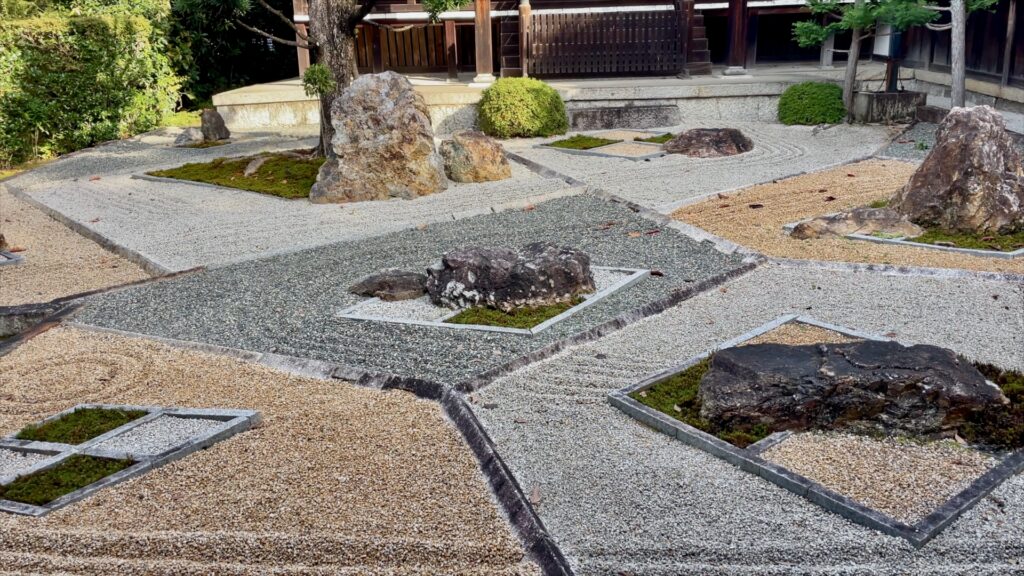
障子越しに広がる光景は、まるで絵画のようです。
控えめな白壁と木の門を背景に、真紅のもみじが燃える炎のように枝を広げています。室内の静けさと外の鮮やかな秋色。その対比が、紅葉の輝きをいっそう際立たせています。
真如堂の庭には、石や苔、そして借景までもが絶妙な調和を見せています。目立ちすぎることなく互いを引き立て合うその姿は、日本庭園の本質 ― 「計算された静けさ」と「自然の華やかさ」の融合 ― を象徴しています。
窓を額縁に見立てれば、この一瞬は「生きた掛け軸」。
真如堂の庭は、訪れる人の心を落ち着かせ、そして鮮やかに彩ってくれるのです。
Through the shoji, the garden unfolds like a living painting.
Against the quiet white wall and wooden gate, crimson maple branches spread out like flames. The contrast between the serene interior and the vivid autumn colors outside makes the leaves shine even brighter.
The gardens of Shinnyodo embody a delicate balance of stones, moss, and borrowed scenery. Each element does not compete but instead enhances the others, symbolizing the essence of a Japanese garden — the union of “calculated silence” and “natural brilliance.”
When the window becomes a frame, the view turns into a “living scroll.”
The gardens of Shinnyodo calm the spirit while filling it with vibrant color.

苔に包まれた島のような石組みと、そこに根を張る大木。周囲を流れる白砂の模様は、水の流れを思わせます。まるで大樹が大地を支え、石がその力強さを象徴しているかのようです。
石と木の共存は、人と自然、あるいは生と死の循環を暗示しているようにも感じられます。力強さと同時に静かな安らぎが漂い、庭全体が「生命の根源」を表現しているように思えます。
The moss-covered stones form an island anchored by towering trees, while the raked white gravel flows around them like water. It feels as though the great trees embody the strength of the earth, with the stones standing as symbols of resilience.
The coexistence of rock and wood suggests the cycle of life and death, or the harmony between humans and nature. There is both strength and tranquility here — a scene that seems to embody the very essence of life itself.

大きな横たわる石は、静かに眠るお釈迦様の姿。周囲の石たちは、嘆き悲しむ弟子や動物たちを思わせます。苔の大地は悠久の時を抱き、白砂の流れはガンジスの川となって、この世界の移ろいと生命の循環を表しています。
「涅槃の庭」は、単なる景観ではなく、仏教の根本思想を目の前に映し出す場です。石と砂だけで人の生死や宇宙の理を語る――まさに枯山水の真髄がここにあります。
The large reclining stone represents the Buddha in his final repose. Surrounding stones suggest the disciples and animals mourning his passing. The moss-covered ground carries the weight of eternity, while the flowing patterns of white gravel evoke the sacred Ganges River, symbolizing the cycle of life and impermanence.
The “Nehan Garden” is not merely a landscape, but a living embodiment of Buddhist philosophy. With nothing more than stones and sand, it tells the profound story of life, death, and the cosmos — the very essence of karesansui.

小さな四阿(あずまや)と竹垣に囲まれた一角は、茶室へとつながる「茶庭」の空間です。踏み石を辿り、紅葉を横目に腰掛けると、庭そのものが心を清める準備の場となります。
茶庭は、単なる通路ではなく「非日常への導入」です。日常の塵を払い、静かに心を整えてから一服の茶に向かう。そこに日本文化が大切にしてきたもてなしと間合いの美学が表れています。
This small pavilion and bamboo fence mark the entrance to the tea garden. Following the stepping stones, with autumn leaves beside you, the space itself becomes a place to purify the mind before entering the tearoom.
The tea garden is not just a path; it is an introduction to the extraordinary. It allows one to leave behind the dust of everyday life, quietly preparing the heart before sharing a single bowl of tea. Here lies the Japanese aesthetic of hospitality and mindful pause.

「随縁の庭」は、現代的な感覚を取り入れながらも、枯山水の本質を失わない独特の庭です。敷き詰められた白砂は区画ごとに形を変え、石と苔を四角や多角形に切り取って配置することで、幾何学模様のような景色を描き出しています。
ここには、時代や環境に応じて姿を変えながらも、根本は変わらないという「随縁(すいえん)」の思想が映し出されています。見る角度や光の具合によって印象が変わり、訪れる人はその変化を通して「今ここにある縁」を感じ取ることができます。
The “Zuien Garden” is a modern interpretation of the karesansui style, created in 2010 by garden designer Shigemori Chisei, a successor of Shigemori Mirei’s lineage. Unlike traditional rock gardens, it features a bold, geometric design: white gravel is divided into sections of varying shapes, with stones and moss set within rectangular or polygonal frames.
The name “Zuien” reflects the Buddhist idea of adapting to conditions — that while forms may change with time and circumstance, the essence remains constant. Depending on the angle or the light, the garden reveals different impressions, inviting visitors to contemplate the fleeting yet profound connections of the present moment.
真如堂の庭は、涅槃の庭に仏教思想の深みを、随縁の庭に現代的な表現を映し出し、さらに茶庭には日常から非日常へと心を切り替える日本文化の美学を宿しています。石と砂、苔と木立、そのすべてが一体となって「仏教の宇宙」を描き出しているのです。
ここでご紹介したのは、ほんの一部にすぎません。
四季折々に表情を変える真如堂の庭の魅力は、写真だけでは語り尽くせません。
👉 詳しくはYouTube動画でご紹介していますので、ぜひご覧ください。
The gardens of Shinnyodo embody multiple layers of expression: the Nehan Garden conveys the depth of Buddhist philosophy, the Zuien Garden introduces a modern interpretation of tradition, and the tea garden offers a mindful transition from everyday life to the extraordinary. Stones, sand, moss, and trees together create a symbolic Buddhist cosmos.
What I have shared here is only a glimpse.
The true beauty of Shinnyodo’s gardens reveals itself through the changing seasons — something that photos alone cannot fully convey.
👉 For a more detailed view, please watch the full video on YouTube.



コメント